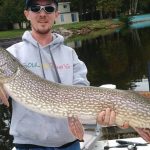Dr. Robert “Rocky” Rockwell, a biology professor at City University of New York and one of North America’s leading authorities on snow geese, says a “bumper crop” of snow geese be in the offing for waterfowl hunters this year.
“This is a huge production year,” says Rockwell, who was concerned about nesting success after last year’s dismal production. “This was the most bizarrely wet year I’ve ever seen up there. The birds nested 9 or 10 days earlier than normal, and as a result nest success was very high.”
“Predicting hunting can be a fool’s errand, and I never like to do it, but the upcoming season appears to be shaping up awfully well,” says Delta Waterfowl President Rob Olson.
“My message to goose hunters is this: get ready. The migration could be packed with young-of-the-year birds.”
Rockwell agrees. He says high nest success means lots of juveniles will be making the flight south.
“We’re talking about juvenile to adult ratios of 1.5 to 1,” says Rockwell, “which means those puppies are going to be sucked right into decoy spreads. Harvest always goes up when you have a high juvenile-to-adult ratio, so I think there’s good opportunity and I think it’s going to be early, because geese are already moving south.”
Rockwell says snow and Ross’ geese are foraging heavily on berries inland from the Hudson Bay coast. Thousands are currently south of the normal La Perouse Bay breeding range near the Broad River and are staging all the way to the Ontario/Manitoba border.
The eastern arctic is also looking good, says Dr. Jim Leafloor, a research scientist for Environment Canada who just returned from a banding program on Baffin Island.
“We’re expecting good production on Baffin, for all species, not just snows,” says Leafloor. “On South Hamption Island it’s the same deal, so the eastern arctic seems to be doing well this year.”
It’s a slightly different story in the central arctic. The migratory bird sanctuary at Karrak Lake south of Queen Maud Gulf is the breeding ground for 10 to 15 percent of the mid-continent snow goose population.
“Production of young at Karrak Lake has declined in the last four years,” says Dr. Ray Alisauskas, a research scientist with Environment Canada who’s been studying the colony since 1991. “There was later-than-average nesting due to delayed snow melt and delays in nutrient storage, stemming from reduced food availability because of very high densities of geese on subarctic feeding areas.”
While nesting productivity is down, Alisauskas says overall populations of both snow and Ross’ geese remain very high. The number of nesting geese at Karrak Lake has grown from 400,000 to more than a million in less than 10 years. A recent assessment found survival rates have not declined since 1989, even with concerted efforts to reduce the population through liberalized hunting regulations and a special spring conservation hunt.
“This harvest is showing that it’s sustainable,” says Alisauskas. “These birds are so resilient. You see video in the spring and you say, ‘Wow these birds are getting pounded quite hard,’ but when you look at the estimates of survival, they haven’t changed in the last 20 years.”
Olson says their sublime taste hasn’t changed in 20 years, either. Delta’s president isn’t a preacher, but he has become an evangelist for snow geese, which he says are among the most underrated waterfowl species for the pot. In fact, he insists they’re among the best.
“I don’t know where the propaganda started, but the myth that snow geese are inedible is just that-a myth,” he said. “I think they’re absolutely delicious-certainly not winged liver, as some have suggested- and I challenge hunters this year to prepare these succulent birds for their friends and family. They won’t be disappointed.”















